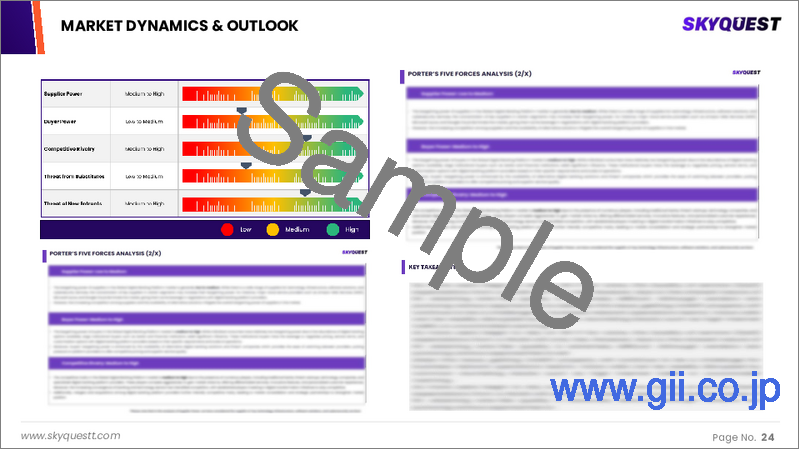|
|
市場調査レポート
商品コード
1663022
有機CMOSイメージセンサの市場規模、シェア、成長分析、画像処理別、配列タイプ別、用途別、産業分野別、地域別 - 産業予測、2025-2032年Organic CMOS Image Sensor Market Size, Share, and Growth Analysis, By Image Processing (2D Sensor, 3D Sensor), By Array Type (Linear Image Sensors, Area Image Sensors), By Applications, By Industry Vertical, By Region - Industry Forecast 2025-2032 |
||||||
|
|||||||
| 有機CMOSイメージセンサの市場規模、シェア、成長分析、画像処理別、配列タイプ別、用途別、産業分野別、地域別 - 産業予測、2025-2032年 |
|
出版日: 2025年02月19日
発行: SkyQuest
ページ情報: 英文 184 Pages
納期: 3~5営業日
|
全表示
- 概要
- 目次
有機CMOSイメージセンサ 2023年の市場規模は16億9,000万米ドルで、2024年の19億米ドルから2032年には48億4,000万米ドルに成長し、予測期間(2025-2032年)のCAGRは12.4%で成長する見通しです。
さまざまな分野で高性能イメージングソリューションの需要が高まっているため、有機CMOSイメージセンサの売上が大幅に増加する見込みです。これらのセンサは、低消費電力、軽量設計、優れた光感度で支持されており、スマートフォンのカメラ、医療用イメージング、監視カメラ、車載カメラなどの用途に最適です。エレクトロニクスにおいて持続可能性が優先されるようになるにつれ、環境に優しい製品に対する需要が高まり、有機CMOSセンサの市場はさらに拡大すると予想されます。さらに、有機半導体技術の進歩は今後の市場成長にとって極めて重要です。特にスマートフォン分野では、コンパクトな設計で高い性能とエネルギー効率を兼ね備えたイメージセンサが広く採用されており、新規参入企業にも既存参入企業にも有望な市場機会がもたらされています。
目次
イントロダクション
- 調査の目的
- 調査範囲
- 定義
調査手法
- 情報調達
- 二次と一次データの方法
- 市場規模予測
- 市場の前提条件と制限
エグゼクティブサマリー
- 世界市場の見通し
- 供給と需要の動向分析
- セグメント別機会分析
市場力学と見通し
- 市場概要
- 市場規模
- 市場力学
- 促進要因と機会
- 抑制要因と課題
- ポーターの分析
主な市場の考察
- 重要成功要因
- 競合の程度
- 主な投資機会
- 市場エコシステム
- 市場の魅力指数(2024年)
- PESTEL分析
- マクロ経済指標
- バリューチェーン分析
- 価格分析
有機CMOSイメージセンサ市場規模:画像処理別
- 市場概要
- 2Dセンサー
- 3Dセンサー
有機CMOSイメージセンサ市場規模:配列タイプ別
- 市場概要
- リニアイメージセンサー
- エリアイメージセンサー
有機CMOSイメージセンサ市場規模:用途別
- 市場概要
- 3Dイメージング
- ビデオ
- マシンビジョン
- 生体認証
- その他
有機CMOSイメージセンサ市場規模:産業分野別
- 市場概要
- 家電
- 自動車
- 医療と生命科学
- セキュリティと監視
- ロボット工学
- その他
有機CMOSイメージセンサ市場規模
- 北米
- 米国
- カナダ
- 欧州
- ドイツ
- スペイン
- フランス
- 英国
- イタリア
- その他欧州地域
- アジア太平洋地域
- 中国
- インド
- 日本
- 韓国
- その他アジア太平洋地域
- ラテンアメリカ
- ブラジル
- その他ラテンアメリカ地域
- 中東・アフリカ
- GCC諸国
- 南アフリカ
- その他中東・アフリカ
競合情報
- 上位5社の比較
- 主要企業の市場ポジショニング(2024年)
- 主な市場企業が採用した戦略
- 最近の市場動向
- 企業の市場シェア分析(2024年)
- 主要企業の企業プロファイル
- 企業の詳細
- 製品ポートフォリオ分析
- 企業のセグメント別シェア分析
- 収益の前年比比較(2022-2024)
主要企業プロファイル
- Sony Corporation(Japan)
- Samsung Electronics Co., Ltd.(South Korea)
- ON Semiconductor Corporation(United States)
- STMicroelectronics N.V.(Switzerland)
- Canon Inc.(Japan)
- SK Hynix Inc.(South Korea)
- Teledyne Technologies Incorporated(United States)
- Panasonic Holdings Corporation(Japan)
- Himax Technologies, Inc.(Taiwan)
- GalaxyCore Shanghai Limited Corporation(China)
- AMS-Osram AG(Austria)
- Analog Devices, Inc.(United States)
- Tower Semiconductor Ltd.(Israel)
- Brillnics Japan Inc.(Japan)
- Anitoa Systems, LLC(United States)
- PixArt Imaging Inc.(Taiwan)
- Hamamatsu Photonics K.K.(Japan)
- BAE Systems plc(United Kingdom)
- Galaxycore Microelectronics(China)
- ANDANTA GmbH(Germany)
結論と提言
Organic CMOS Image Sensor Market size was valued at USD 1.69 billion in 2023 and is poised to grow from USD 1.9 billion in 2024 to USD 4.84 billion by 2032, growing at a CAGR of 12.4% during the forecast period (2025-2032).
The rising demand for high-performance imaging solutions across multiple sectors is set to significantly boost sales of organic CMOS image sensors. These sensors are favored for their low power consumption, lightweight design, and superior light sensitivity, making them ideal for applications in smartphone cameras, medical imaging, surveillance, and automotive cameras. As sustainability becomes a priority in electronics, the demand for eco-friendly products is expected to further enhance the market for organic CMOS sensors. Furthermore, advancements in organic semiconductor technology will be pivotal for future market growth. The widespread adoption of image sensors that combine enhanced performance with energy efficiency in compact designs, particularly in the smartphone sector, presents promising opportunities for both new and established market players.
Top-down and bottom-up approaches were used to estimate and validate the size of the Organic CMOS Image Sensor market and to estimate the size of various other dependent submarkets. The research methodology used to estimate the market size includes the following details: The key players in the market were identified through secondary research, and their market shares in the respective regions were determined through primary and secondary research. This entire procedure includes the study of the annual and financial reports of the top market players and extensive interviews for key insights from industry leaders such as CEOs, VPs, directors, and marketing executives. All percentage shares split, and breakdowns were determined using secondary sources and verified through Primary sources. All possible parameters that affect the markets covered in this research study have been accounted for, viewed in extensive detail, verified through primary research, and analyzed to get the final quantitative and qualitative data.
Organic CMOS Image Sensor Market Segments Analysis
Global Organic CMOS Image Sensor Market is segmented by Image Processing, Array Type, Applications, Industry Vertical and region. Based on Image Processing, the market is segmented into 2D Sensor and 3D Sensor. Based on Array Type, the market is segmented into Linear Image Sensors and Area Image Sensors. Based on Applications, the market is segmented into 3D Imaging, Video, Machine Vision, Biometrics and Others. Based on Industry Vertical, the market is segmented into Consumer Electronics, Automotive, Medical and Life Sciences, Security and Surveillance, Robotics and Others. Based on region, the market is segmented into North America, Europe, Asia Pacific, Latin America and Middle East & Africa.
Driver of the Organic CMOS Image Sensor Market
The Organic CMOS Image Sensor market is experiencing significant growth fueled by the escalating demand for smartphone cameras. The surge in smartphone sales over recent years has created a substantial market for these advanced imaging technologies. As consumers increasingly seek better camera quality for their devices, the advantages of organic CMOS image sensors-such as enhanced image quality, lower power consumption, and superior sensitivity-are becoming more recognized. This growing awareness, combined with the smartphone industry's expansion, is likely to propel the demand for organic CMOS image sensors, making them a crucial component in the future of mobile photography.
Restraints in the Organic CMOS Image Sensor Market
The Organic CMOS Image Sensor market faces significant constraints due to limited market penetration. Traditional silicon-based sensors have long been established and are generally more cost-effective and efficient than organic alternatives in most aspects. As a result, the adoption of organic CMOS image sensors remains relatively low, which is expected to hinder market growth in the long term. This reluctance to shift from established silicon technology poses a challenge for the organic sector, making it difficult to achieve widespread acceptance and ultimately limiting the potential expansion of the Organic CMOS Image Sensor market.
Market Trends of the Organic CMOS Image Sensor Market
The Organic CMOS Image Sensor market is experiencing a notable surge driven by the growing demand for advanced low-light imaging solutions. As consumers and industries alike seek enhanced night vision capabilities-particularly in applications ranging from smartphone cameras to security systems-the organic CMOS technology's superior low-light performance positions it as a key player. This trend is further fueled by innovations in imaging technology, enabling clearer, more detailed images in challenging lighting conditions. Consequently, organizations specializing in organic CMOS sensors are poised to leverage this demand, unlocking new avenues for growth and establishing their dominance in the competitive imaging market landscape.
Table of Contents
Introduction
- Objectives of the Study
- Scope of the Report
- Definitions
Research Methodology
- Information Procurement
- Secondary & Primary Data Methods
- Market Size Estimation
- Market Assumptions & Limitations
Executive Summary
- Global Market Outlook
- Supply & Demand Trend Analysis
- Segmental Opportunity Analysis
Market Dynamics & Outlook
- Market Overview
- Market Size
- Market Dynamics
- Drivers & Opportunities
- Restraints & Challenges
- Porters Analysis
- Competitive rivalry
- Threat of substitute
- Bargaining power of buyers
- Threat of new entrants
- Bargaining power of suppliers
Key Market Insights
- Key Success Factors
- Degree of Competition
- Top Investment Pockets
- Market Ecosystem
- Market Attractiveness Index, 2024
- PESTEL Analysis
- Macro-Economic Indicators
- Value Chain Analysis
- Pricing Analysis
Global Organic CMOS Image Sensor Market Size by Image Processing & CAGR (2025-2032)
- Market Overview
- 2D Sensor
- 3D Sensor
Global Organic CMOS Image Sensor Market Size by Array Type & CAGR (2025-2032)
- Market Overview
- Linear Image Sensors
- Area Image Sensors
Global Organic CMOS Image Sensor Market Size by Applications & CAGR (2025-2032)
- Market Overview
- 3D Imaging
- Video
- Machine Vision
- Biometrics
- Others
Global Organic CMOS Image Sensor Market Size by Industry Vertical & CAGR (2025-2032)
- Market Overview
- Consumer Electronics
- Automotive
- Medical and Life Sciences
- Security and Surveillance
- Robotics
- Others
Global Organic CMOS Image Sensor Market Size & CAGR (2025-2032)
- North America (Image Processing, Array Type, Applications, Industry Vertical)
- US
- Canada
- Europe (Image Processing, Array Type, Applications, Industry Vertical)
- Germany
- Spain
- France
- UK
- Italy
- Rest of Europe
- Asia Pacific (Image Processing, Array Type, Applications, Industry Vertical)
- China
- India
- Japan
- South Korea
- Rest of Asia-Pacific
- Latin America (Image Processing, Array Type, Applications, Industry Vertical)
- Brazil
- Rest of Latin America
- Middle East & Africa (Image Processing, Array Type, Applications, Industry Vertical)
- GCC Countries
- South Africa
- Rest of Middle East & Africa
Competitive Intelligence
- Top 5 Player Comparison
- Market Positioning of Key Players, 2024
- Strategies Adopted by Key Market Players
- Recent Developments in the Market
- Company Market Share Analysis, 2024
- Company Profiles of All Key Players
- Company Details
- Product Portfolio Analysis
- Company's Segmental Share Analysis
- Revenue Y-O-Y Comparison (2022-2024)
Key Company Profiles
- Sony Corporation (Japan)
- Company Overview
- Business Segment Overview
- Financial Updates
- Key Developments
- Samsung Electronics Co., Ltd. (South Korea)
- Company Overview
- Business Segment Overview
- Financial Updates
- Key Developments
- ON Semiconductor Corporation (United States)
- Company Overview
- Business Segment Overview
- Financial Updates
- Key Developments
- STMicroelectronics N.V. (Switzerland)
- Company Overview
- Business Segment Overview
- Financial Updates
- Key Developments
- Canon Inc. (Japan)
- Company Overview
- Business Segment Overview
- Financial Updates
- Key Developments
- SK Hynix Inc. (South Korea)
- Company Overview
- Business Segment Overview
- Financial Updates
- Key Developments
- Teledyne Technologies Incorporated (United States)
- Company Overview
- Business Segment Overview
- Financial Updates
- Key Developments
- Panasonic Holdings Corporation (Japan)
- Company Overview
- Business Segment Overview
- Financial Updates
- Key Developments
- Himax Technologies, Inc. (Taiwan)
- Company Overview
- Business Segment Overview
- Financial Updates
- Key Developments
- GalaxyCore Shanghai Limited Corporation (China)
- Company Overview
- Business Segment Overview
- Financial Updates
- Key Developments
- AMS-Osram AG (Austria)
- Company Overview
- Business Segment Overview
- Financial Updates
- Key Developments
- Analog Devices, Inc. (United States)
- Company Overview
- Business Segment Overview
- Financial Updates
- Key Developments
- Tower Semiconductor Ltd. (Israel)
- Company Overview
- Business Segment Overview
- Financial Updates
- Key Developments
- Brillnics Japan Inc. (Japan)
- Company Overview
- Business Segment Overview
- Financial Updates
- Key Developments
- Anitoa Systems, LLC (United States)
- Company Overview
- Business Segment Overview
- Financial Updates
- Key Developments
- PixArt Imaging Inc. (Taiwan)
- Company Overview
- Business Segment Overview
- Financial Updates
- Key Developments
- Hamamatsu Photonics K.K. (Japan)
- Company Overview
- Business Segment Overview
- Financial Updates
- Key Developments
- BAE Systems plc (United Kingdom)
- Company Overview
- Business Segment Overview
- Financial Updates
- Key Developments
- Galaxycore Microelectronics (China)
- Company Overview
- Business Segment Overview
- Financial Updates
- Key Developments
- ANDANTA GmbH (Germany)
- Company Overview
- Business Segment Overview
- Financial Updates
- Key Developments





